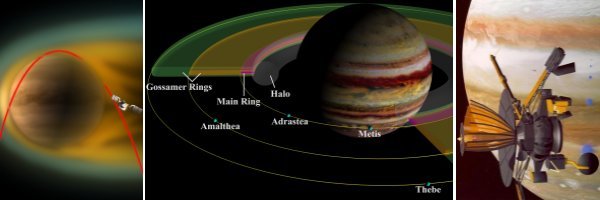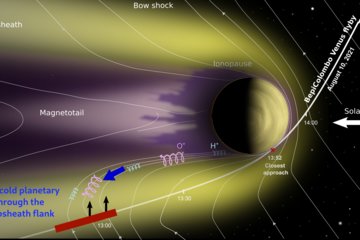
Research about the planetary plasma environment
Archived page
Introduction to Planetary Plasmas
Beside the commonly known states of matter - the solid, liquid and gaseous phase - there exist more exotic states. One is the plasma state. This is a gas that does not consist only out of neutral particles, but also to a large fraction out of ions and electrons. On earth plasmas can be found in lightning discharges as well as in the ionosphere. They have technological applications in plasma displays and experimental fusion reactors. Since stars also consist of plasma, most of the visible universe is in this state of matter.

The magnetosphere of Mercury

In contrast to the other terrestrial planets Mercury does not have an atmosphere, but it has a relatively weak magnetic field. The strong solar UV radiation leads to photo-chemical escape of ions from Mercury's surface. Also solar wind protons can penetrate through the magnetospheric cusps and sputter ions off the surface. Due to the absence of an ionosphere no significant energy can be stored in the magnetosphere of Mercury such that solar wind disturbances will lead to short time deformations of the magnetosphere.
With plasma instrumentation onboard a spacecraft it is possible to observe the escape of ions from Mercury's surface and analyze surface composition and evolution. Also we can study reconnection processes between solar wind and planetary magnetic fields on very short time scales. For this purpose the Planetary Plasma Group contributes to the plasma instrumentation of the Bepi Colombo Mission to Mercury which was launched in 2018. The mission consists of the Japanese Mercury Magnetospheric Orbiter (MMO) that contains a large set of ion, electron and field spectrometers and the European Mercury Planetary Orbiter (MPO) that contains ion and neutral spectrometers.

The ionosphere and magnetosphere of Venus

In contrast to planets like the Earth, Jupiter or Saturn, Venus does not have an intrinsic magnetic field and thus its atmosphere is not protected against the incoming solar wind. However, solar UV radiation ionizes the upper atmosphere creating an ionosphere which in turn interacts with the solar wind ions and the magnetic field carried by the solar wind. This interaction leads to the formation of a magnetosphere: the solar wind magnetic field lines are "folded" around Venus, so the plasma flow is directed around the planet. Depending on the balance between internal pressure (exerted by ionospheric plasma) and external pressure (exerted by solar wind plasma), the positions of ionopause and magnetopause vary in altitude.
The ionosphere is assumed to display two distinct states, "magnetized" and "unmagnetized", depending on the penetration depth of the solar wind magnetic field. Accordingly, the electron transport in the ionosphere changes with varying magnetic field configurations. These aspects are currently being studied by the Planetary Plasma Group at MPS.
Between April 2006 and February 2015, the Venus Express spacecraft was in orbit around Venus. The onboard "Analyzer of Space Plasmas and Energetic Atoms", ASPERA-4, comprised several sensors for in-situ investigation of the Venusian plasma environment and the interactions taking place. The Ion Mass Analyser (IMA) was a mass spectrograph designed to detect ions such as H+, He+ and O+ as well as molecular ions in an energy range between 10 eV/e and 40 keV/e. When Venus Express entered the ionosphere on its trajectory, heavy planetary ions could be analyzed. The Electron Spectrometer (ELS) measured electron densities and energies from 5eV up to 20 keV with a maximum time resolution of 4 seconds. During each orbit of Venus Express, the electron measurements can be used to infer the positions of the bow shock and the ionopause. For the investigation of neutral particles, ASPERA-4 contains the NPI (Neutral Particle Imager) and NPD (Neutral Particle Detector). These instruments measured the flux of energetic neutral atoms with high angular resolution, as well as their masses and energies within a range from 0.1 to 10 keV.
Together with the onboard magnetometer, these instruments yielded a large range of information on the dynamical processes taking place in the plasma environment of Venus. Furthermore, the current data can be compared with the measurements of the Pioneer Venus Orbiter (PVO) which investigated the planet Venus between 1980 and 1992, so that long-term variations (e.g. dependence of features on solar activity) can be explored in detail.
The magnetosphere of the Earth

Our planet Earth has an intrinsic magnetic field. Charged particles become trapped on these magnetic field lines, forming the Earth's magnetosphere. The impact of solar wind particles causes the lines facing the Sun to be compressed. On the other hand, the magnetic field lines facing away from the Sun get stretched and elongated, forming the Earth's magnetotail.
A number of layers and boundaries can be observed in near-Earth space where the solar wind and Earth's magnetic field meet. The first is the Earth's bow shock created when the supersonic solar wind is suddenly slowed as it approaches the magnetosphere. The edge of the magnetosphere is known as the magnetopause. There are two weak points in Earth's defenses, cusps which occur above the planet's north and south magnetic poles. Particles from the solar wind leak into the magnetosphere towards the Earth along magnetic field lines and cause the auroras.
These regions are explored in great detail by Cluster which delivers data since December 2000. Cluster comprises four identical satellites which fly around the Earth in a tetrahedral configuration. This allows studying small-scale structures of the magnetosphere and its environment in three dimensions. Onboard the Cluster satellites are the Research with Adaptive Particle Imaging Detectors (RAPID) that measure energetic particles in the energy range from 30 keV to 4 MeV. The acceleration mechanisms of energetic particles (particularly reconnection) and their composition in different magnetospheric regions are studied using this instrument. The measurements by RAPID play an important role in understanding of the magnetic storms and substorms.

The ionosphere and magnetosphere of Mars

Similar to Venus the planet Mars does have an ionosphere but no global intrinsic magnetic field. Only in the southern hemisphere of the planet exist strong remnant crustal magnetizations. This leads to a complicated pattern of interaction of the ionosphere of Mars with the solar wind: while in the northern hemisphere a stable ionopause and magnetic barrier is formed, in the southern hemisphere features similar to the Earth cusps can be observed.
The Mars Express spacecraft carries the ASPERA-3 plasma instrument which comprises the ion spectrometer IMA with an energy range of 10 eV up to 40 keV, the electron spectrometer ELS (5 eV to 27 keV) and two neutral atom sensors. Unfortunately no magnetometer was included in the Mars Express payload, but the MARSIS radar instrument allows determining local electron density and total magnetic field at the spacecraft position as well as remote ionospheric density profiles. The mass discrimination by the IMA sensor allows measuring the flow and escape of oxygen ions from the upper ionosphere of Mars. The study of the oxygen escape processes is crucial for the understanding of the evolution of water in the Martian atmosphere. The Planetary Plasma Group investigates all the different features of magnetospheric physics at Mars.


The magnetosphere of Saturn

Saturn has an intrinsic magnetic field that creates the second largest magnetosphere in the solar system. It combines properties of the magnetospheres of Jupiter and Earth. The global configuration resembles Jupiter in that respect that the main plasma source is not external (i.e. the solar wind), but internal (plasma production from Saturn's moons and rings). The fast rotation of the planet provides energy and centrifugally transports the internally produced plasma outwards which creates a pancake shaped magnetosphere. The nature of the internal plasma source has been an open question for a long time. With Cassini it could finally be identified as the water geysers located on the south-pole of the moon Enceladus. Saturn resembles Earth in the respect that the mechanism of the aurora is suggested to be the same as Earth and that the solar wind exerts partial control of several other processes.
From 2004 to 2017 the Cassini spacecraft was orbiting Saturn. Onboard is the Magnetospheric Imaging Instrument (MIMI). It consists of the Charge Energy Mass Spectrometer (CHEMS), the Low Energy Magnetospheric Measurement System (LEMMS) and the Ion Neutral Camera (INCA). While CHEMS could measure intensities and composition of ions with low energies (3 keV/e to 220 keV/e), LEMMS measured intensities of high energetic charged particles (10 keV to several MeV). INCA is able to measure intensities and directions of motion of either ions or energetic neutral atoms (ENA) (7 keV/nuc to 3 MeV/nuc).
One of the research topics of the Planetary Plasma Group at MPS was the study of Saturn's magnetosphere based on in-situ plasma observations and simulations. MIMI data is used to study Saturn's magnetosphere and its dynamic processes in detail. This includes studies on dynamic and steady state plasma transport. Large scale mapping of the particle distributions revealed the existence of a radiation belt that only forms in case of enhanced energetic particle flux of the Sun. MIMI data can also be used for comparison with models or can deliver input parameter for simulations.
The data of the MIMI instrument can also be used to study neutral particles and macroscopic objects. This is possible because these objects can deplete the amount of plasma and energetic particles which are measured by MIMI. By using this fact the discovery of previously unknown new ring arcs around Saturn has been achieved. Such findings could afterwards be correlated with remote observations by Cassini (e.g. the cameras).



















